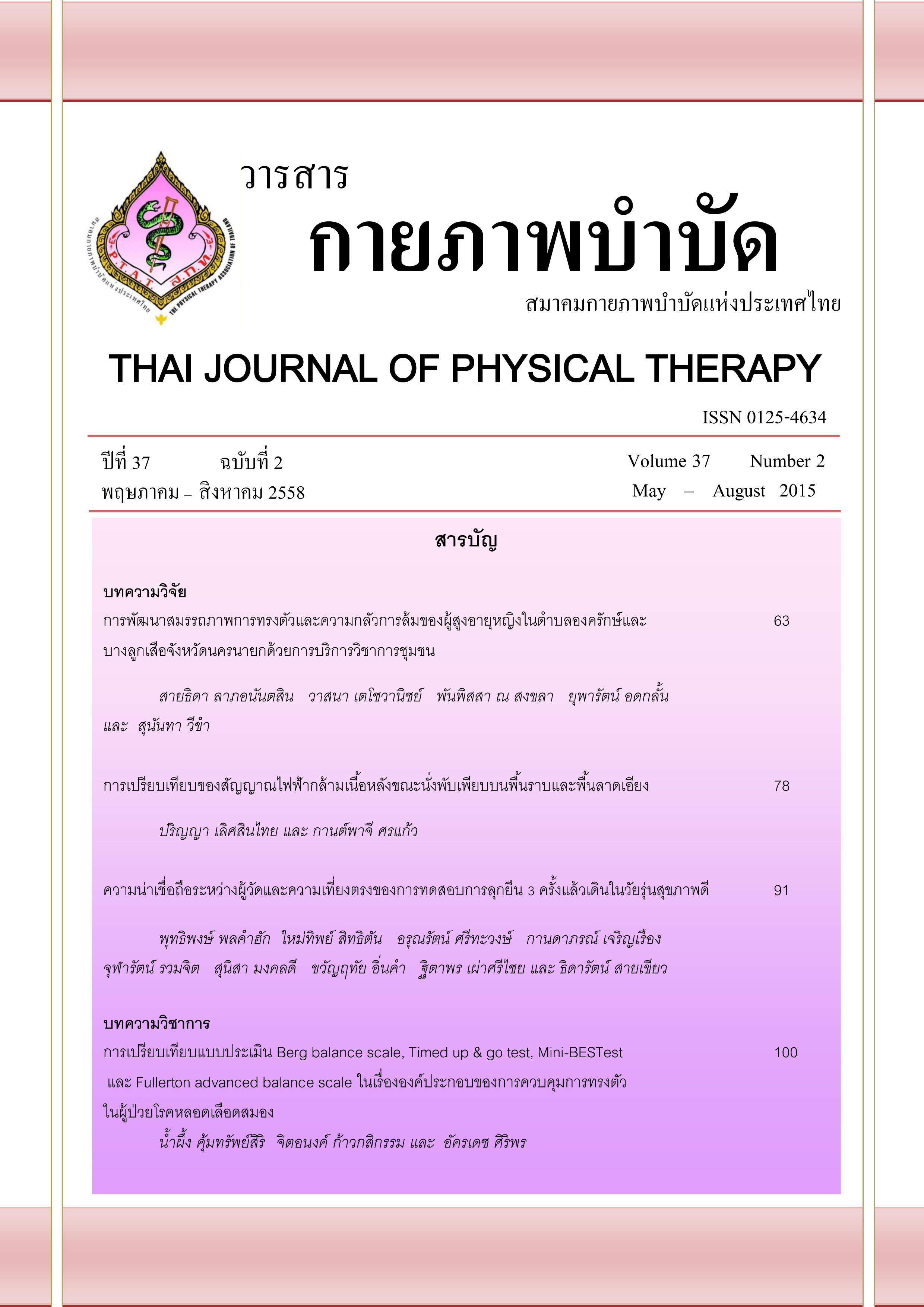การเปรียบเทียบของสัญญาณไฟฟ้ากล้ามเนื้อขณะนั่งพับเพียบบนพื้นราบ และพื้นลาดเอียง
Main Article Content
บทคัดย่อ
การวิจัยครั้งนี้มีวัตถุประสงค์เพื่อ เปรียบเทียบการทำงานของกล้ามเนื้อหลัง(Multifidus; MF และ Iliocostalis lumborum; IL) ด้วยวิธีการวัดสัญญาณไฟฟ้ากล้ามเนื้อภายนอก (surface electromyography, sEMG) ระหว่างท่านั่งพับเพียบบนพื้นราบกับพื้นลาดเอียง ในอาสาสมัครสุขภาพดีจำนวน 15 คน (ชาย 2 คน หญิง 13 คน) ค่าเฉลี่ย (mean ± SD) ของอายุ 21.01±1.98 ปี และ ดัชนีมวลกาย (BMI) 21.02 ±1.89 กก./ม2 จากการสังเกตพบว่าอาสาสมัครทั้งหมดนั่งพับเพียบทับด้านตรงข้ามกับความถนัดของขา และค่าเฉลี่ย (mean ± SD) ของมุมพื้นปรับระดับลาดเอียงที่ทำให้อาสาสมัครรู้สึกสบายขณะนั่งพับเพียบบนพื้นลาดเอียงมีค่าเท่ากับ 11.33±2.79 องศา ผลการเปรียบเทียบค่า %MVIC (µv) ในกล้ามเนื้อ MFและ IL ระหว่างด้านโค้งเว้า (concave side) และด้านโค้งนูน (convex side) ของแนวกระดูกสันหลัง ขณะนั่งพับเพียบบนพื้นราบ และขณะนั่งพับเพียบบนพื้นลาดเอียง พบว่า ค่าเปอร์เซ็นต์สัญญาณไฟฟ้าของกล้ามเนื้อทั้ง 2 ด้านทำงานไม่แตกต่างกันทั้ง 2 ท่า (p>0.05) ยกเว้น, ค่าสัญญาณไฟฟ้ากล้ามเนื้อ MF ทางด้านโค้งเว้า เมื่ออยู่ในท่านั่งพื้นลาดเอียงที่มีค่าลดลงอย่างมีนัยสำคัญทางสถิติเมื่อเปรียบเทียบกับท่านั่งพื้นราบ (p<0.05, Paired T-test ที่ระดับความเชื่อมั่น 95%)
ผลการวิจัยสรุปได้ว่า อาสาสมัครมีความรู้สึกสบายขณะนั่งพับเพียบบนพื้นลาดเอียง และค่า %MVIC ของกล้ามเนื้อ MF ของด้านโค้งเว้า (concave side) เมื่ออยู่ในท่านั่งพับเพียบบนพื้นลาดเอียงมีการทำงานของกล้ามเนื้อลดลง และกล้ามเนื้อ MF ทั้ง 2 ด้านของกระดูกสันหลังมีการทำงานที่สมดุลมากขึ้น (muscle balance) เมื่อเทียบกับท่านั่งพับเพียบบนพื้นราบ
Article Details
เอกสารอ้างอิง
2. Thai etiquette: Sitting [Internet]. 2015 [cited 2015 Mar 16]. Available from: http://www.seameo.org/vl/thaiet/index1.htm.
3. Norkin CC, Levangie PK. Basic concepts in biomechanics. In: Norkin CC and Levangie PK, editors. Joint structure and function: a comprehensive analysis. 2nd ed. Philadephia: F.A. Davis company; 1992. p.1-56.
4. de Looze MP, Kuijt-Everst LF, van Dieen JV. Sitting comfort and discomfort and the relationship with objective measures. Ergonomics 2003;46(10):985-97.
5. Skaggs DL. Adolescent idiopathic scoliosis: an update. Am Fam Physician 1996;May(15):2327-35.
6. Greiner KA. Adolescent idiopathic scoliosis: radiologic decision-making. Am Fam Physician 1996;May(15):2327-35.
7. Valachi B, Valachi K. Mechanism leading to musculoskeletal disorders in dentistry. J Am Dent Assoc 2003; 134:1344-50.
8. ภานุพันธ์ ทรงเจริญ. กลุ่มอาการเส้นประสาทถูกกดทับในส่วนขา. ใน: ภานุพันธ์ ทรงเจริญ, บรรจง มไหสวริยะ บรรณาธิการ การบาดเจ็บของเส้นประสาท. กรุงเทพฯ เรือนแก้วการพิมพ์; 2539.หน้า 247-79.
9. Greendale GA, Nili NS, Huang MH, Seeger L, Karlamangla AS. The reliability and validity of three non-radiological measures of thoracic kyphosis and their relations to the standing radiological Cobb angle. Osteoporos Int 2011;22(6):1897-905.
10. Rheault W, Ferris S, Foley JA, Schaffhauser D, Smith R. Intertester reliability of the flexible ruler for the cervical spine. J Orthop Sports Phys Ther 1989;10(7):254-6.
11. Fridlund AJ, Cacioppo JT. Guidelines for human electromyographic research. Psychophysiology 1986;23(5):567-89.
12. Cram JR, Kasman GS, Holtz J. Introduction to surface electromyography. 1st ed. Maryland: Aspen publishers. Inc; 1998.
13. Merletti R, Rainoldi A, Farina D. Surface electromyography for noninvasive characterization of muscle. Exercise and Sport Sciences Reviews 2001;29(1):20-5.
14. Ng JK, Richardson CA. Reliability of electromyographic power spectral analysis of back muscle endurance in healthy subjects. Arch Phys Med Rehabil 1996;77:259-64.
15. Dankaerts W, O’Sullivan PB, Burnett AF, et al. Reliability of EMG measurements for trunk muscles during maximal and sub-maximal voluntary isometric contractions in healthy controls and CLBP patients. Journal of Electromyography and Kinesiology 2004;14(3):333-42.
16. Ng JK, Richardson CA, Jull GA. Electromyographic amplitude and frequency changes in the iliocostalis lumborum and multifidus muscles during a trunk holding test. Phys Ther 1997;77(9):954-61.
17. Velotta J, Weyer J, Ramirez A, Winstead J, Bahamonde R. Relationship between leg dominance tests and type of task. Portuguese Journal of Sport Sciences 2011;11(suppl 2):1035-8.
18. Hoffman M, Schrader J, applegate T, Koceja D. Unilateral postural control of the functionally dominant and nondominant extremities of health subjects. J Athel Train1998:33(4):319-22.
19. Geffen P, Veltink PH, Koopman BF. Can pelvis angle be monitored from seat support forces in healthy subjects? 2009 J Biomech Eng [Internet]. [cited 2015 Mar 1];131(3):034502. Available from: http://biomechanical.asmedigitalcollection.asme.org/article.aspx?articleid=1423952
20. van Geffen P, Reenalda J, Veltink PH, Koopman BF. Decoupled pelvis rotation in sitting: a passive motion technique that regulates buttock load associated with pressure ulcer development. J Biomech 2009 ;42(9):1288-94.
21. Kurazumi Y, Matsubara N, Horikoshi T. Effect of posture on the heat transfer areas of the human body. Building and Environment 2008;43(10):1555-65.
22. Massion J. Postural control system. Curr Opin Neurobiol 1994;4(6):877-87.
23. Anderson SM. Spinal curves and scoliosis. Radiol Technol 2007;79(1):44-65.
24. Taft E, Francis R. Evaluation and management of scoliosis. J Pediatr Health Care 2003;17(1):42-4.
25. Fidler MW, Jowett RL. Muscle imbalance in the aetiology of scoliosis. Journal of bone and joint surgery 1976; 2:6-7.
26. Cassidy JD, Brandell BR, Nykoliation JW, Wedge J. The role of paraspinal muscle in the pathogenesis of idiopathic scoliosis: a preliminary EMG study. JCCA 1987;31(4): 179-84.
27. Ng JK, Richardson CA, Kippers V, Parnianpour M. Relationship between muscle fiber composition and functional capacity of back muscles in healthy subjects and patients with back pain. J Orthop Sports Phys Ther 1998;27(6):389-402.
28. O'Sullivan PB, Grahamslaw KM, Kendell M, Lapenskie SC, Moller NE, Richards KV. The effect of different standing and sitting postures on trunk muscle activity in a pain-free population. Spine 2002;27(11):1238-44.
29. Ng JK, Richardson CA. Reliability of electromyographic power spectral analysis of back muscle endurance in healthy subjects. Arch Phys Med Rehabil 1996; 77(3): 259-64.
30. Bergmark A. Stability of the lumbar spine. A study in mechanical engineering. Acta Orthop Scand Suppl 1989; 230: 1-54.


